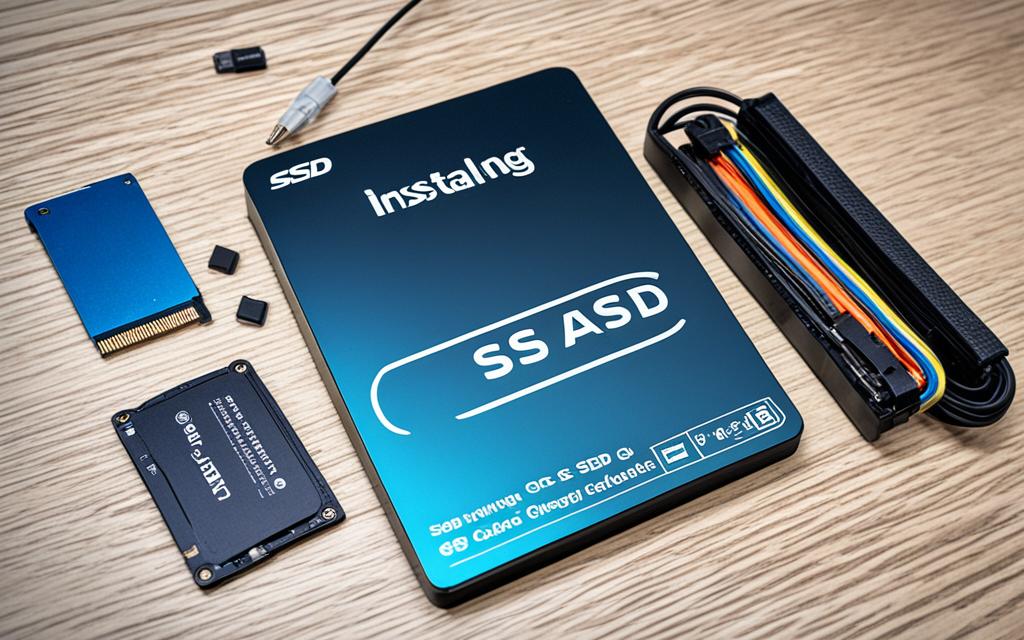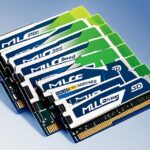Table of Contents
Putting a new operating system on an SSD might seem tricky, but it’s key for making your computer faster. When you install an OS on a new SSD, you choose the path of unmatched speed and efficiency. This SSD installation guide is here to help with every step for a smooth Windows installation. We’ll explain SSDs and how to fix any problems you might face. With this guide, you’ll make the most of your computer’s new power.
Key Takeaways
- Installation time for Windows on an SSD averages between 25-30 minutes1.
- Windows 11 requires a minimum of 4 GB RAM and 64 GB of storage2.
- Backups are essential prior to any OS installation to prevent data loss.
- Choosing the right partition style for your SSD is crucial to avoid installation errors.
- Expert services are available to assist with any Windows update errors or installation issues.
Introduction to SSDs and Operating Systems
Solid-state drives (SSDs) have changed how we store data, making our interaction with operating systems faster. They use SSD technology, which is based on flash memory. This allows for quicker data access than what we see with hard disk drives (HDDs). Thanks to SSDs, users enjoy faster boot times and quicker application launches, which is very important in our quick-moving digital world.
Getting to know OS basics helps us understand the vital part operating systems play. They manage the computer’s hardware resources and provide a bridge between the user and the machine. This ensures that software runs smoothly. With an SSD, operating systems perform better, boosting both speed and efficiency. This improvement is a big deal for tasks that need lots of resources, like gaming and productivity software.
SSDs also help save money, cutting costs by 60-70% compared to HDDs. But it’s worth mentioning that SSDs may need replacing more often due to wear. To keep up performance and reliability when switching to SSDs, updating the firmware is crucial. SSDs offer a great mix of speed and storage, making our computing experience much better. They allow users to move through operating systems more smoothly34.
Understanding Operating Systems
An operating system (OS) is crucial because it connects computer hardware with application programs. Its OS definition includes important functions for efficient interaction with devices. These OS functions encompass memory allocation, process scheduling, and managing files. Knowing these functions is important for anyone wanting to improve their computer use.
Another important concept is operating system migration. This is when you switch from one OS to another or upgrade your storage from a hard disk drive (HDD) to a solid-state drive (SSD). When moving to a new SSD, you can choose from clean installing, cloning your system disk, or migrating Windows to SSD5.
Doing a clean install is best for performance because it removes unnecessary files. But, cloning your disk means copying everything to a new drive which should be as big as the original. On the other hand, migrating Windows only moves the required parts for starting up, which is great for smaller drives5.
It’s very important to prepare before you start migrating. This means backing up important files and listing the applications you need. Good preparation helps make the moving process easier and avoids problems during the migration.
| Migration Method | Description | Advantages |
|---|---|---|
| Clean Install | Fresh installation of the OS on the SSD | Best performance; removes old files |
| Clone Disk | Copying all contents directly from the HDD to SSD | Maintains existing configuration; less setup time |
| Migrate Windows | Copying only the OS and necessary partitions | Ideal for smaller SSDs; faster process |
SSD technology is crucial for better OS performance. SSDs are much faster than HDDs, greatly improving how quick the system responds and boots up. Using SSDs helps make devices work better and faster, pushing people to upgrade their systems with SSDs6.
Benefits of Using an SSD
Switching from old HDDs to SSDs offers lots of benefits. SSDs are much faster, making computers work up to 100 times quicker. This means your laptop can perform 10-15 times better, especially with SSDs compared to old HDDs78. Being fast helps a lot in gaming, making videos, and moving big files9.
SSDs are also more reliable. They don’t have moving parts, so they’re tough and use less battery. This is great for laptops78. Plus, they are quiet because they don’t have the noisy parts HDDs have, making them good for peaceful places9.
Even though SSDs cost more initially, they are worth it. They make your device faster and more efficient. As prices have dropped, more people can afford them9. SSDs are also tiny, fitting easily into many gadgets. With all new Mac laptops and many desktops using SSDs, it’s clear that everyone is moving to SSDs7. This change signals a big move towards better technology9.
Preparing for Installation
Before you start installing an OS on a new SSD, it’s vital to prepare properly. Make sure all your important data is backed up. This stops you from losing key files during the switch. SSDs are now more popular for Windows 10 because they work faster than old hard drives. The demand for SSDs has gone up, especially with recent price cuts.
After backing up your data, get your SSD ready. It’s crucial to initialise your SSD the right way to make it work its best. You need to pick between MBR or GPT partition styles. It depends on what your operating system needs. Setting up your SSD might need a SATA-to-USB adapter, especially if space is tight. People often upgrade to SSDs for quicker boot times and smoother use, showing how SSDs are better than HDDs10.
Installing Windows cleanly improves its function but means you have to clear old data from the HDD. Getting rid of old stuff makes things run better. It keeps the SSD from filling up with old system files. Some users prefer cloning their OS onto the SSD instead of a clean install. Both ways have their advantages, letting you choose what’s best for you.
| Preparation Step | Description |
|---|---|
| Backup Data | Ensure all important files are securely backed up to prevent loss. |
| Initialise SSD | Choose MBR or GPT partition style for the new SSD based on OS requirements. |
| Declutter HDD | Free up space on the old HDD by removing unnecessary files and programs. |
| Connect SSD | Use a SATA-to-USB adapter if needed for proper connection to the system. |
By taking these steps to prepare, you’re ready to install the OS on your SSD. This careful preparation protects your data. It also boosts the performance of your new setup11.
How to Install an OS on a New SSD
Installing an OS on a new SSD is important. You can clone an existing OS or do a clean install. Cloning keeps settings and apps the same. This makes the changeover smooth. A clean install offers a new beginning. It’s good for better performance. Switching to an SSD boosts reliability and speeds up starting your computer. This upgrade appeals to many12.
Selecting the Right Installation Method
Choosing cloning or a clean install depends on your needs. Cloning is easy with tools like Acronis True Image. It lets you adjust sizes and move data effortlessly. But, a clean install needs you to download the OS again. A clean install fixes space problems and boosts performance12. On average, installing Windows anew takes 25-30 minutes1.
Creating Bootable Windows Installation Media
To start fresh, you need bootable media. Here’s how:
- Download the Windows Media Creation Tool from the official Microsoft website.
- Insert a USB drive (8GB minimum) into your computer.
- Run the Media Creation Tool and select “Create installation media for another PC.”
- Choose your language, edition, and whether you need 32-bit or 64-bit.
- Pick “USB flash drive” and follow the steps to finish.
With your bootable media ready, setting up your new OS is the next step. Follow the right guidelines to make installation smooth. Backing up your files first is crucial. It keeps your data safe during the switch. Remember, new technology like SSDs make computers work better.
| Installation Method | Time Required | Benefits |
|---|---|---|
| Cloning | 30-45 minutes | Keeps settings and apps |
| Clean Install | 25-30 minutes | New start, fixes space problems |
Steps for a Clean Install of Windows on an SSD
To install Windows on a new SSD, you must follow the steps carefully. Prepare to make the process easier, ensuring your files are safe and the SSD is ready. This guide will show you how to back up your data and prepare the SSD, leading to better speed and performance.
Backing Up Data
First, secure a data backup before starting the install. It protects your files from being lost during the setup. Here’s how to ensure your files are safe:
- Pick a medium for backup like an external hard drive, cloud storage, or another SSD.
- Put your files into folders for easier backup.
- Use software or your system’s backup features to save your data.
Give yourself enough time for backing up, as it varies by the data amount.
Formatting the SSD
After the data backup, format the SSD for the new system. This clears previous data and gets it ready. To format, do the following:
- Connect the SSD to your PC and use Disk Management.
- Find your SSD on the list of drives.
- Right-click the SSD and choose ‘Format’.
- Pick NTFS as the file system and opt for quick format.
- Finish the setup and wait for it to complete.
Improper format can cause issues, like compatibility errors with Windows 1013. Once done, the SSD is set for installing Windows.
Follow these steps for an easier install and better computer performance. SSDs boost speed significantly, by up to 100 times more than HDDs14. Backing up and formatting correctly is crucial for a great experience14.
Configuring Your SSD as a Boot Drive
To start setting up your new SSD as the main drive, you need to adjust BIOS settings. Press a key like F2, Del, or Esc during startup to enter the BIOS. Next, find the Boot section to change the boot sequence.
Here, pick your SSD as Boot Option #1. This ensures your PC boots from the SSD first. Setting this up usually takes 3-5 minutes15. Don’t forget to save your changes before leaving the BIOS, or the old settings will stay in place.
After doing this, your computer should start up using the SSD. If your SSD isn’t set up like the main disk, you might face issues16. Software like AOMEI Partition Assistant Professional can help. It makes setting up your SSD easy and guides you through the whole process17.
Before starting, back up your important files to an external drive. This keeps your data safe if something goes wrong during setup15. By following these tips, your computer will work better and start faster, improving your overall experience.
| Task | Estimated Time |
|---|---|
| Access BIOS | 1-2 minutes |
| Adjust Boot Order | 3-5 minutes |
| Save and Exit | 1 minute |
| Total Duration | 5-8 minutes |
Troubleshooting Installation Issues
Having trouble installing an OS can be a headache. However, most problems have simple fixes. When you try to install an OS on a new SSD, you might see errors. These include the system not seeing the SSD or installation hiccups. First, double-check your BIOS settings to make sure the SSD is recognised. Wrong BIOS settings often cause trouble. Switching to AHCI mode might help your system spot the SSD better18.
Make sure your SSD is set up right before you install anything. It has to be formatted correctly to avoid installation issues. If you’re not sure, you can use the Windows Media Creation Tool. This tool helps with partitioning and can solve many installation problems for resolving installation problems. Also, double-check that everything is plugged in right. Loose or bad connections often cause SSDs to go undetected.
Look at your system’s guide for more help. It’s important that your SSD works with your motherboard and other parts. If you still can’t get it to work, maybe it’s time to ask for help. Sometimes, another person can find a solution you missed. With careful checking and a little patience, you can fix most OS installation problems.
| Issue | Common Causes | Troubleshooting Tips |
|---|---|---|
| SSD not recognised | Incorrect BIOS settings, faulty connections | Check BIOS settings and secure connections |
| Installation errors | Corrupt Windows media, outdated BIOS | Repair Windows media, update BIOS |
| Boot failures | Improper disk formatting, failed AHCI mode | Convert SSD to GPT/MBR, enable AHCI mode |
Conclusion
Switching to a solid-state drive (SSD) can really boost your computer’s speed. SSDs work much faster than old hard drives. This is why people are eager to put Windows on their new SSD laptops. It speeds up starting up and makes everything run smoother1920. If you plan well, whether you’re cloning your old system or starting fresh, you’ll find the process straightforward.
SSDs are great for many reasons. They’re tough and don’t make much noise, which is good for both home and work1920. Make sure to back up your files and prepare your SSD right to avoid any setup issues. Setting up your OS on an SSD might seem tough at first, but it will make your computer much quicker and more efficient, finishing our thoughts on SSDs.
Upgrading to an SSD can take your computer to the next level. It takes some planning, but the outcome is very rewarding. Step into the SSD world and see the big change in your computer’s performance. It opens up new possibilities for what your computer can do.
FAQ
What is an SSD and how does it differ from an HDD?
An SSD, or solid-state drive, stores data on flash memory. This means it’s much faster than an HDD, which uses moving parts. An SSD improves your computer’s performance and is more reliable.
Why should I consider installing an operating system on an SSD?
Putting an operating system on an SSD makes your computer start up and open programs quicker. You’ll notice a smoother and faster performance during daily use and when running big programs.
What preparation is necessary before installing an OS on an SSD?
First, back up your important data to avoid losing it. Make sure the SSD is correctly installed and your computer can see it. Choose the right partition style—MBR or GPT—for your operating system.
What are the benefits of performing a clean installation of an OS?
A clean OS installation gives your system a new beginning. It clears out old errors and clutter. This leads to a more stable and efficient computer.
How do I create bootable Windows installation media?
Use the Windows Media Creation Tool to make a USB drive for installing Windows. It helps you easily install a fresh Windows on your SSD.
What steps should I follow to perform a clean installation of Windows on my SSD?
Start by saving all important files elsewhere. Then, format the SSD for installation. Use disk management tools safely for these steps. Make sure you have your installation media ready and follow the setup instructions for Windows.
How can I set my SSD as the primary boot drive?
Change the boot order in your BIOS settings when you start up. Ensure it recognises the SSD first. This step is crucial for the OS to boot from the SSD.
What common issues might I face during the OS installation process?
If you hit installation errors or the system won’t start from the SSD, check your BIOS settings again. Make sure the SSD is formatted and set up right. Also, check all connections are tight.
Source Links
- https://www.easeus.com/partition-master/install-windows-10-on-ssd.html – How to Install Windows on SSD via 2 Easy Ways 🏆
- https://www.wps.com/blog/how-to-install-windows-1011-on-new-solid-state-drive-ssd-in-easy-steps/ – How to Install Windows 10/11 on New Solid State Drive(SSD)? (In Easy Steps) | WPS Office Blog
- https://mobiletrans.wondershare.com/how-to/transfer-os-to-ssd.html – How to Transfer OS to SSD in Windows: A Step-by-step Guide [2024]
- https://www.easeus.com/partition-manager-software/install-os-on-ssd-everything-else-on-hdd.html – How to Install Operating System on SSD and Everything Else on HDD
- https://www.partitionwizard.com/clone-disk/clean-install-disk-clone-migrate-system.html – New SSD, Clean Install or Clone Disk or Migrate Windows OS? – MiniTool Partition Wizard
- https://www.easeus.com/partition-manager-software/use-ssd-for-os-only.html – Easy and Step-by-Step Guide to Use SSD for OS Only
- https://www.kingston.com/en/blog/pc-performance/benefits-of-ssd – The 5 Benefits of SSDs over Hard Drives- Kingston Technology
- https://www.diskpart.com/articles/using-ssd-for-os-and-hdd-for-storage-3889i.html – Best Strategy of Using SSD for OS and HDD for Storage on Windows
- https://www.backblaze.com/blog/ssd-upgrade-guide/ – How to Upgrade Your Computer: Migrating from HDD to SDD
- https://www.ubackup.com/windows-10/install-windows-10-to-ssd.html – Directly Install Windows 10 on New SSD with/without CD | 2 Ways
- https://www.diskpart.com/windows-10/install-windows-10-on-ssd-4348.html – How to Install Windows 10 on SSD Easily and Successfully
- https://www.acronis.com/en-gb/blog/posts/how-to-move-os-to-another-drive/ – How To Move OS To Another Drive – Complete Guide & Software
- https://www.isumsoft.com/windows-10/install-windows-10-on-new-ssd.html – Fresh Install Windows 10 on New SSD without Removing Old HDD
- https://www.diskpart.com/ssd-management/install-windows-on-ssd-0528.html – [2 Ways] How to Install Windows 11, 10, 8, 7 on SSD?
- https://www.easeus.com/partition-master/set-ssd-as-boot-drive.html – How to Set SSD as Boot Drive [2024 Updated]
- https://www.xda-developers.com/how-turn-ssd-boot-drive/ – How to turn your SSD into a boot drive for your new or existing computer
- https://www.diskpart.com/articles/set-ssd-as-boot-drive-0825.html – How to Set SSD as Boot Drive in Windows 11, 10, 8, 7?
- https://www.partitionwizard.com/partitionmanager/win10-wont-install-on-ssd.html – Quickly and Easily to Fix Windows 10 Won’t Install on SSD – MiniTool Partition Wizard
- https://www.diskpart.com/articles/how-to-install-windows-on-new-ssd-laptop-1503.html – How to Install Windows on New SSD Laptop [Easy Guide]
- https://www.passfab.com/partition-manager/install-windows-10-on-new-ssd.html – Step-by-step Guide on How to Install Windows on New SSD








